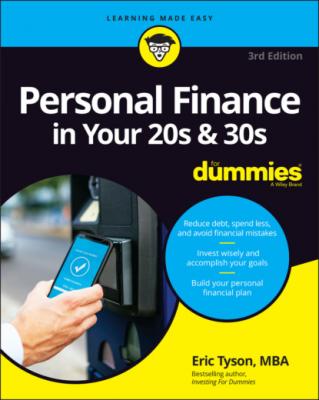ТОП просматриваемых книг сайта:
Personal Finance in Your 20s & 30s For Dummies. Eric Tyson
Читать онлайн.Название Personal Finance in Your 20s & 30s For Dummies
Год выпуска 0
isbn 9781119805458
Автор произведения Eric Tyson
Жанр Личные финансы
Издательство John Wiley & Sons Limited
The icons in this book help you find information you need:
Beyond the Book
To view this book’s Cheat Sheet, simply go to www.dummies.com and enter “Personal Finance in Your 20s and 30s For Dummies Cheat Sheet” in the Search box. There you’ll get quick tips on understanding financial basics, managing day-to-day finances, and growing your money through basic investing.
Where to Go from Here
This book is organized so you can go wherever you want to find complete information. Want advice on minimizing your taxes, for example? Go to Part 2 for that. You can use the table of contents to find broad categories of information or the index to look up more specific topics.
If you’re not sure where to go, you may want to start with Part 1. It gives you all the basic info you need to assess your financial situation and points to places where you can find more detailed information for improving it.
Part 1
Getting Started with Personal Finance
IN THIS PART …
Evaluate your net worth, savings rate, credit health, investment portfolio, and insurance coverage.
Develop a savings mindset, as well as budgeting and saving strategies.
Conquer consumer debt and recognize the best uses for loans and the types of debt to avoid.
Get and understand your credit report and credit score. Use your credit report and other tools to prevent identity theft.
Chapter 1
Your Financial Checkup
IN THIS CHAPTER
Where did your childhood years go? Was it that long ago that you were concerned with what exams you had coming up, what you might be doing over your summer break, and what kind of job you were interested in and qualified to do?
As a young adult, you wonder where you are going to live, how much a decent apartment will cost, and how much you will actually have left over after taxes and those other pesky deductions that are taken from your paycheck. How much will it cost to buy a home that you’ll really want? What are the best ways to save and invest your money?
And then life throws you a curveball like the COVID-19 government-mandated shutdowns which turned plenty of young people’s lives upside down in a way that few saw coming. Or perhaps an aging parent or other relative needs some help. How can you handle these situations personally and financially?
Those are some pretty big questions that even people 20 and 30 years older than you struggle to answer. You’re wise to be thinking about these topics now. In this chapter, I help you start to answer those questions by showing you how to evaluate your net worth (addressing any debt, such as student loans, credit cards, or auto or other consumer loans). I also help you assess your savings rate, credit health, investment portfolio, and insurance coverage so you can develop and implement a winning plan tailored to your situation.
Calculating Your Financial Worth
Having a sense of what you own (your assets) and what you owe (your liabilities) is important because it provides some measure of your financial security and your ability to accomplish financial goals such as buying a desired car, buying a home, traveling, starting a business, or retiring someday.
In this section, I define net worth and then walk you through the relatively simple calculations of determining your own personal net worth.
Defining net worth
Your net worth is quite simply your financial assets (for example, checking, savings, and investment accounts) minus your financial liabilities (debts such as student loans and credit-card debt). In the following sections, I walk you through how to perform these calculations.
Figuring what you own: Financial assets
To calculate your financial assets, access your checking/savings, and investment account records, including retirement accounts and any other documentation that can help you. You may have only one or two accounts, and that’s fine. The COVID-19 pandemic has proven the absolute need for emergency fund savings. Add up all the values of these accounts to find out what you own.
It’s common for most young adults to be in the early stages of accumulating assets. This book helps you change and improve upon that.
In addition to excluding personal property and possessions because folks don’t generally sell those to accomplish their personal and financial goals, I would also probably exclude your home as an asset if you happen to own one. (You can include it if you expect to downsize or to rent in retirement and live off of

